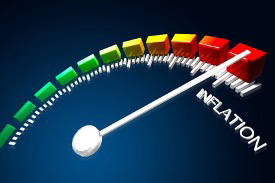Authored by Clint Siegner, moneymetals
Everyone loves an early inflation. The effects at the beginning of an inflation are all good. There is steepened money expansion, rising government spending, increased government budget deficits, booming stock markets, and spectacular general prosperity, all in the midst of temporarily stable prices. Everyone benefits, and no one pays…
In the terminal inflation, there is faltering prosperity, tightness of money, falling stock markets, rising taxes, still larger government deficits, and still roaring money expansion, now accompanied by soaring prices and ineffectiveness of all traditional remedies. Everyone pays and no one benefits. That is the full cycle of every inflation.
America may now be entering the part of the inflation cycle nobody likes. The feeling of prosperity cultivated by COVID stimulus payments, expanded unemployment benefits and student loan forbearance is wearing off.
Prices for goods and services caught up with the temporary surge in incomes. Bank savings are disappearing.
Real incomes are in steady decline and Americans are finding the only enduring effect of all that stimulus is higher prices.

The illusion of prosperity fades in the end.
The next round of stimulus and lower interest rates is almost certainly on the way, but it probably won’t provide the same artificial boost. People are relearning how this story ends, and the confidence underpinning the value of the fiat dollar is eroding.
Any effect is likely to be smaller and shorter in duration, if there is any effect at all besides immediately higher prices.
Officials can borrow and print new money, but they can’t produce actual wealth. They can’t create abundant goods and services for people to purchase with all those extra dollars.
Bureaucracy is a leech on the private sector and its ability to produce the stuff which makes peoples’ lives better. Unfortunately, the leech keeps growing.
Last week, Republican leadership crafted a debt ceiling agreement which enjoyed more support from Democrats than from members of their own party. The misnamed Fiscal Responsibility Act of 2023 provides for unlimited deficits, at least for the next two years.
Not even our government is immune to the pinch of the later stages of inflation. Interest payments on federal debt are consuming ever larger portions of the federal budget. The dollars needed to make these payments will be borrowed. It is a spiral of rising debt and higher payments.
Even more troubling are growing signs of weakness in the private sector. As mentioned above, real wages are steadily declining. The Leading Economic Indicators are falling. The yield curve is inverting. Virtually every reliable measure is signaling the US economy will soon be in recession.
The one exception is the Bureau of Labor Statistic reporting on the jobs market.
Last week the BLS issued another blockbuster report which showed businesses created 339,000 new jobs, about 85,000 more than economists predicted. It was just the latest in a string of reports to beat expectations.
For many, the jobs data is just too good to be true. The BLS has a long history of cooking the data to paint a rosy picture.
And we know from history how politicians are liable to act in the later part of an inflation cycle they created. This is the part where politicians and agency bureaucrats actively try to hide the economic havoc and dodge responsibility.
Views: 75